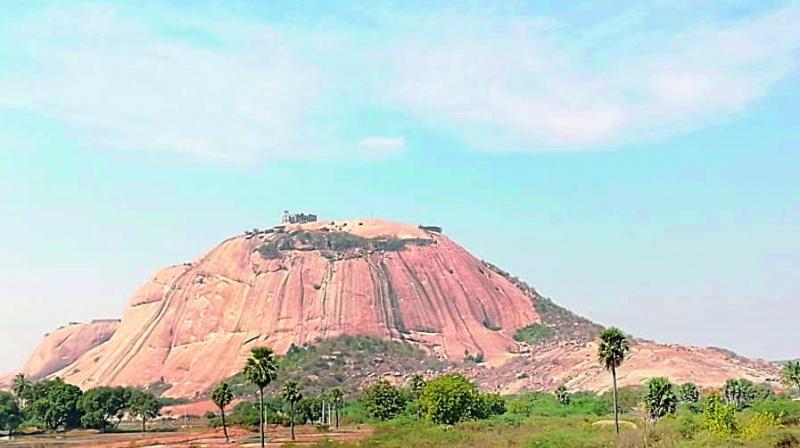Bhongir Fort rocks in the middle of town
It was built on the monolith by Western Chalukya ruler Tribhuvanamalla Vikramaditya-VI, in 1076.

Hyderabad: You may have passed by it on way to Warangal, but may not have paid attention. The fort sits on a huge rock right in the middle of Bhongir town. The road to it is so crowded that there is no time to pause and look at the smooth chunk of rock called a Basso Monolith, the second largest in Asia.
As one looks at this massive rock at the top of which sits the fort, one can only marvel at the audacity of the builders in first scaling the rock and then building the fort at the top. Of course, in those days, forts were built to discourage enemy intrusion so the more inaccessible the better.
It was originally called Tribhuvangiri and later became Bhuvanagiri and now Bhongir. Incidentally, the refurbished Yadadri temple is just 15 km from Bhongir town in the Yadadri Bhuvanagiri district of Telangana. So combining the two places is a good idea for a weekend trip out of Hyderabad.
The Bhongir Fort was built by the Western Chalukya ruler Tribhu-vanamalla Vikramaditya-VI, in 1076. It’s a tough climb to the top. There are steps without railings till midway. It then gets steeper and oddly, hotter. Luckily, the last bit has railings. Breathtaking views await you at the top.
You can wander through the ruins of stone walls and archways. Depending on the season, there is water in the small craters, adding some life to this rock. This was probably a method used to collect spring water. Mandapas and other structures also dot the top of this monolithic structure.
If you go for the sole purpose of seeing the rock and the fort, then do not take the main road. The narrow lanes of the village are quaint and flanked by old houses that people still live in. Some have been converted into little shops, but the doors, balconies, and windows have been left untouched.
Then you cross an old guesthouse belonging to the Nizams and right opposite the fort on the side of the main road is an old post office from the era of the Nizams which has recently been painted and looks very swanky.
Further along there is an old police outpost. The buildings could have been guesthouses, kitchen, dining hall and tourist bungalow, but now they are used by the police to keep seized vehicles.
There is the old-style Bhongir railway station. We always see it from the train, never from the station side and it is beautiful and well maintained. Along the main street of the town are a number of khadi shops selling material at very reasonable prices.
The fort passed into the hands of the Kakatiya dynasty which followed the Chalukyas and they added their own touches. Some of the inscriptions in the fort are in Kannada and Telugu.
If you take the time to walk around this rock, you will see that it is inaccessible from almost anywhere and this says much for the engineering skills of yore. Modern constructions, though, have crept up, abutting the wall of the fort. Right in front of the entrance to the fort are tiffin centres that hide the beauty of the old walls
The Bhongir fort was renovated by the Musunuri Nayaks and then was ceded to the Bahamani Sultans in the 15th century when it was taken over by a local governor. Later, it was used as a prison by the Qutub Shahis. The British did not pay much attention to the rock or fort and this small town and fort faded into obscurity.
A Lord Hanuman temple is situated at the beginning of the steps to the fort. But what catches one’s attention is a huge nammam, shanka and chakra on either side.
There is also a board announcing a rock climbing school which functions on weekends.
While no one has seen it, an underground corridor is believed to exist which connects this fort to the Golconda Fort. Royalty often kept escape routes ready to get away from invaders.

